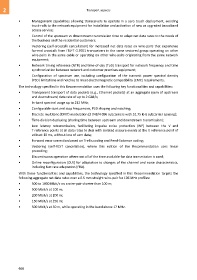Page 676 - 5G Basics - Core Network Aspects
P. 676
2 Transport aspects
• Management capabilities allowing transceivers to operate in a zero touch deployment, avoiding
truck-rolls to the network equipment for installation and activation of new or upgraded broadband
access service;
• Control of the upstream vs downstream transmission time to adapt net data rates to the needs of
the business and the residential customers;
• Vectoring (self-crosstalk cancellation) for increased net data rates on wire-pairs that experience
far-end crosstalk from ITU-T G.9701 transceivers in the same vectored group operating on other
wire-pairs in the same cable or operating on other wire-pairs originating from the same network
equipment;
• Network timing reference (NTR) and time-of-day (ToD) transport for network frequency and time
synchronization between network and customer premises equipment;
• Configuration of spectrum use, including configuration of the transmit power spectral density
(PSD) limitations and notches to meet electromagnetic compatibility (EMC) requirements.
The technology specified in this Recommendation uses the following key functionalities and capabilities:
• Transparent transport of data packets (e.g., Ethernet packets) at an aggregate (sum of upstream
and downstream) data rate of up to 2 Gbit/s;
• In-band spectral usage up to 212 MHz;
• Configurable start and stop frequencies, PSD shaping and notching;
• Discrete multitone (DMT) modulation (2 048/4 096 subcarriers with 51.75 kHz subcarrier spacing);
• Time-division duplexing (sharing time between upstream and downstream transmission);
• Low latency retransmission, facilitating impulse noise protection (INP) between the V and
T reference points at all data rates to deal with isolated erasure events at the U reference point of
at least 10 ms, without loss of user data;
• Forward error correction based on Trellis coding and Reed-Solomon coding;
• Vectoring (self-FEXT cancellation), where this edition of the Recommendation uses linear
precoding;
• Discontinuous operation where not all of the time available for data transmission is used;
• Online reconfiguration (OLR) for adaptation to changes of the channel and noise characteristics,
including fast rate adaptation (FRA).
With these functionalities and capabilities, the technology specified in this Recommendation targets the
following aggregate net data rates over a 0.5 mm straight wire-pair for 106 MHz profiles:
• 500 to 1000 Mbit/s on a wire-pair shorter than 100 m;
• 500 Mbit/s at 100 m;
• 200 Mbit/s at 200 m;
• 150 Mbit/s at 250 m;
• 500 Mbit/s at 50 m, while operating in the band above 17 MHz.
666

